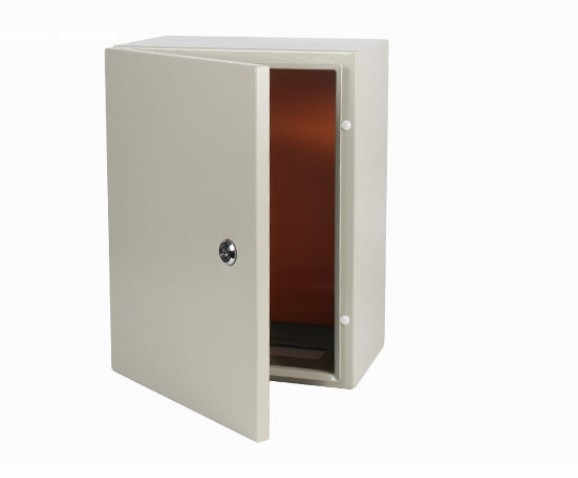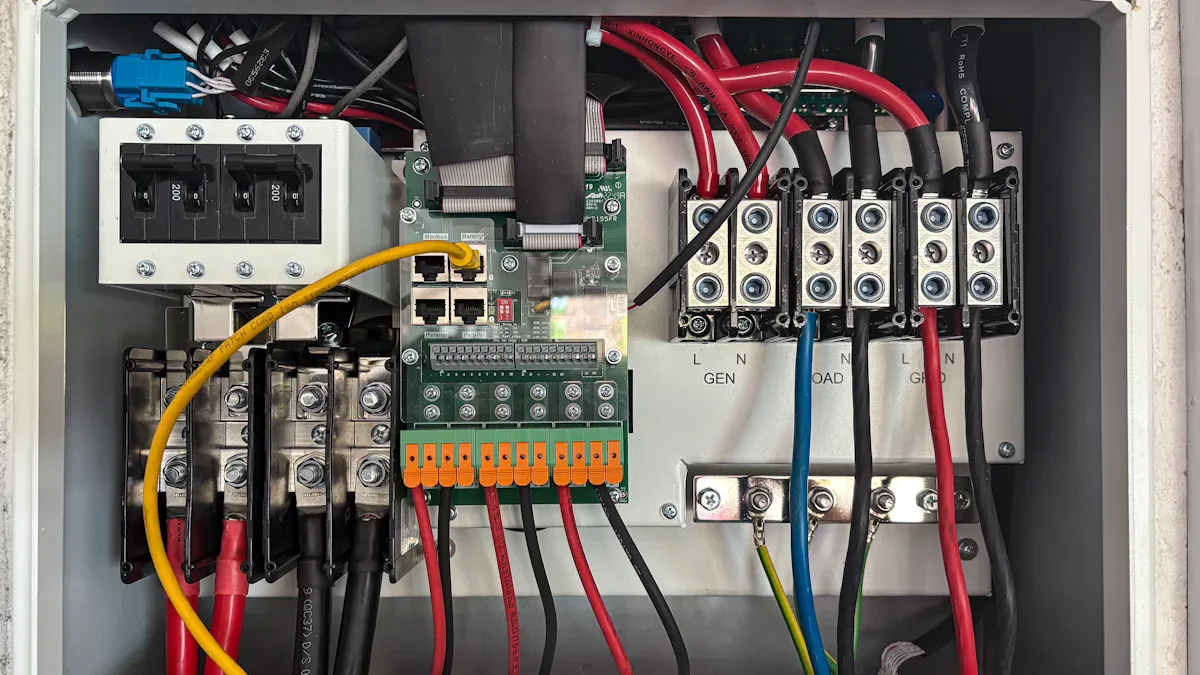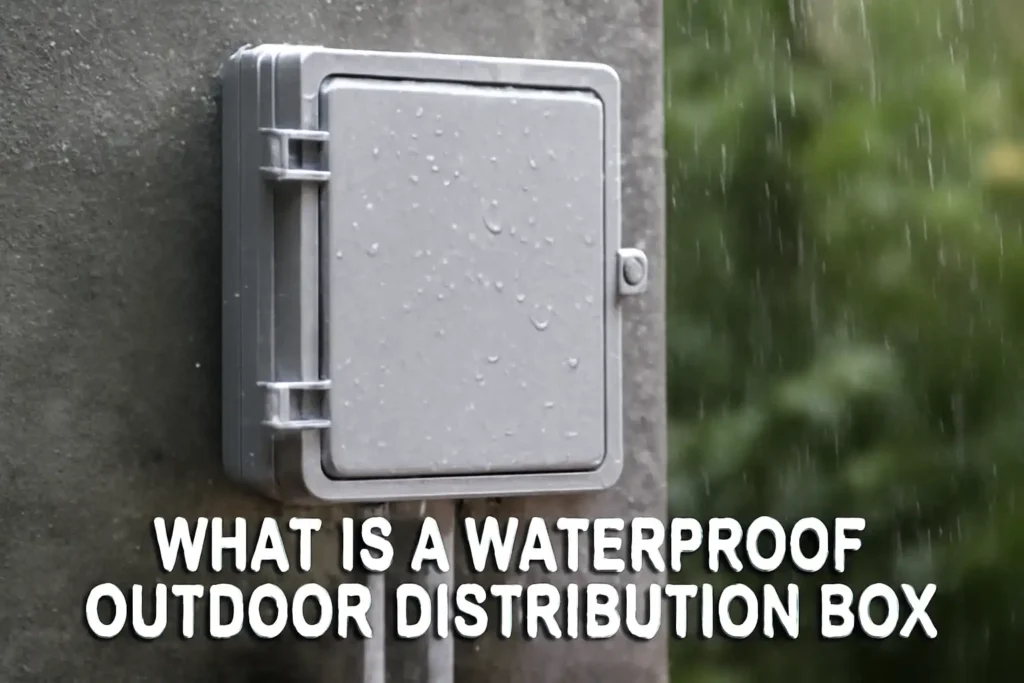You use a waterproof outdoor power distribution box to keep electrical connections safe from rain and dust. It also protects them from other bad weather. This kind of box keeps wires, switches, and outlets safe. It helps you avoid short circuits or electrical fires. You can trust these boxes to give power safely to things outside. These things include garden lights, pumps, or security systems. The boxes have strong seals and tough materials. They help you keep power working well in any outdoor place.
Key Takeaways
- A waterproof outdoor power distribution box keeps electrical connections safe from water, dust, and bad weather. This helps outdoor devices stay safe and work well.
- These boxes have strong parts like bus bars and seals. They use tough materials like ABS plastic or stainless steel. This stops damage and keeps away electrical dangers.
- You should look for high IP or NEMA ratings like IP65 or IP68. These ratings mean the box can block water and dust. It works even in floods or heavy rain.
- Install the box the right way and check it often. Seal cable entries and look for damage. This helps the box last longer and keeps your power system safe.
- Pick the right box material and rating for your area. Always follow safety rules or get a professional if you are not sure.
What Is a Waterproof Outdoor Distribution Box

Purpose
A waterproof outdoor distribution box keeps your electrical systems safe outside. It stops rain, dust, and floods from hurting your equipment. This helps stop short circuits and fires when storms or floods happen. People use these boxes in gardens, tunnels, basements, and wet places. Some boxes have drains to get rid of water fast. This helps stop electrical problems before they start.
- You can use a distribution box to:
- Keep electrical equipment safe from water and wetness.
- Make sure power stays on during floods or heavy rain.
- Help things work safely in damp places like underground rooms.
- Save extra electricity for bad weather, like in solar energy systems.
- Give overload and lightning protection to your devices.
- Help with smart control and safe power outdoors.
Tip: Check and take care of your distribution box often. This helps it stay waterproof for a long time.
Main Parts
A waterproof outdoor distribution box has many important parts. Each part helps keep your electrical system safe and working. Here is a table that lists the main parts and what they do:
| Part | Function |
|---|---|
| Bus bars | Move electricity inside the box and link all circuits |
| Neutral Link | Give a way for current to return and keep things working right |
| Grounding Bus bar | Send extra current to the ground to stop shocks or fires |
| Enclosure | Keep all inside parts safe from damage, dust, and water |
| Electrical Wiring | Link solar panels or other gear with safety devices like circuit breakers |
| Surge Protective Device | Protect against power surges, like from lightning or faults |
| Indication Lights | Show the status of the main power supply |
You will also see modular electric parts inside. These let you add things like circuit breakers for more safety. Many boxes use strong materials like ABS plastic, stainless steel, or aluminum. These materials do not break easily and last a long time. Some boxes meet tough rules like NEMA 4X or IP65. This means they work well even in hard outdoor places.
Note: Waterproof distribution boxes get tested in tough ways. Tests check for leaks, how strong the box is, and if it keeps out dust and water. Good boxes can handle strong water sprays and even being under water. You can trust them in rough places.
How It Works
Power Flow
When you use a waterproof outdoor power box, electricity enters through a main cable. The box directs this power to different circuits inside. Each circuit has its own breaker or fuse. These breakers help control the flow of electricity and stop it if something goes wrong. You connect your outdoor devices, like lights or pumps, to these circuits. The box keeps all wires organized and protected. This setup lets you turn off one part without affecting the others. You get safe and steady power for all your outdoor needs.
The design of the box keeps water and dust away from the electrical parts. This helps prevent short circuits and keeps your devices running even during storms.
Safety Features
You want your outdoor power system to stay safe in any weather. Manufacturers build these boxes with many safety features to protect you and your equipment. Here are some important points:
- Many boxes have IP68 ratings. This means they block water and dust completely. You can even submerge them in water for a long time without damage.
- Silicone seals, gaskets, and screw-on lids keep water out. These parts make sure the box stays tightly closed.
- Good installation matters. You need to prepare cables well, mount the box securely, and seal cable entries with glands or glue. Always check that gaskets sit in the right place.
- Strong materials like polycarbonate, ABS plastic, stainless steel, aluminum, or fiberglass make the box tough. These materials resist impacts and do not rust.
- IP ratings show how much protection the box gives. IP68 boxes offer the best airtightness and keep out water and dust. This lowers the risk of short circuits and stops corrosion.
- If you do not seal the box right or connect wires poorly, water can get in. Always check the gasket for damage before closing the box.
- These boxes protect your system from rain, dust, and sun. This helps your outdoor power setup last longer and work better.
Tip: Always follow the instructions when installing your box. This helps keep your system safe and working for years.
Distribution Box Features
Waterproof vs. Weatherproof
When you shop for an outdoor distribution box, you may see “waterproof” and “weatherproof.” These words seem alike, but they are not the same. A weatherproof box keeps out rain, dust, and splashes. It works outside, but it cannot go underwater. A waterproof box gives more safety. It keeps water out even if it falls in a puddle or flood.
You can use this table to see how waterproof and weatherproof ratings are different:
| Rating Type | Protection Focus | Waterproof vs Weatherproof Clarification |
|---|---|---|
| NEMA 3 / IP54 | Rain, splashing water, dust | Weatherproof; good for outdoor use, not for submersion |
| NEMA 4 / IP66 | Water jets, dust | Weatherproof with higher water resistance; not for full immersion |
| NEMA 6 / IP67, IP68 | Temporary or prolonged water immersion | Waterproof; safe for submersion in water |
If you want to keep your electrical system safe from heavy rain or floods, pick a waterproof distribution box with a high IP or NEMA rating.
Materials
The material you choose for your distribution box matters a lot. It affects how long the box lasts and how well it protects your things. You can pick ABS plastic, aluminum, or stainless steel. Each one has its own good points and best uses.
| Material | Durability Characteristics | Environmental Suitability |
|---|---|---|
| ABS Plastic | Good strength and impact resistance; can get brittle in sunlight without UV protection | Best for shaded or low UV areas; lightweight |
| Aluminum | Lightweight; resists rust due to a special oxide layer; strong but can dent | Great for humid or coastal places |
| Stainless Steel | Very strong; resists rust and corrosion; heavier and costs more | Best for harsh, marine, or industrial settings |
ABS plastic is light and does not cost much. It can take bumps and drops, but sun can make it weak unless it has UV protection. Aluminum is strong and does not rust. It is easy to carry and good for wet or salty air. Stainless steel, like SS316, gives the best safety. It does not rust, even near the sea, but it is heavy and costs more. Some boxes use special plastics or metal with coatings to stop rust and block electromagnetic waves.
Many distribution boxes have UL, CE, or other safety marks. These marks show the box passed hard tests for safety and quality.
NEMA and IP Ratings
You should check the NEMA and IP ratings before you buy a distribution box. These ratings tell you how well the box keeps out water, dust, and other things. NEMA ratings are used in North America. They show how the box protects from water, dust, rust, and how long the seals last. IP ratings have two numbers. The first number shows how well the box blocks dust. The second number shows how well it keeps out water.
For example, a box with an IP65 rating keeps out dust and strong water jets. A box with an IP67 or IP68 rating can go underwater for a short or long time. NEMA 4 and 4X boxes protect from rain, dust, and hose water. NEMA 6 and 6P boxes can go underwater for a while. These ratings help you pick the right box for your outdoor job.
| Parameter | Value |
|---|---|
| Protection Class (IP Degree) | IP65 |
| Max Rated Insulation Voltage | AC1000V / DC1500V |
| Impact Strength (IK Degree) | IK08 |
| Standards | IEC60529, EN 60309 |
Always pick a distribution box with the right rating for your weather and safety needs. This helps your electrical system last longer and keeps you safe from rain, dust, snow, and sun.
Applications

Outdoor Uses
You can use a waterproof outdoor power distribution box in many places around your home or business. These boxes protect electrical connections from rain, dirt, and debris. You often see them in gardens, parks, and yards. People use them for outdoor lighting, water pumps, and even pool equipment. If you have LED signs or security cameras outside, you need a strong box to keep the power safe. Sports stadiums also use these boxes to power bright lights. In one coastal city, a stadium used raintight power supplies to keep the lights on during storms. The boxes worked well, even with salty air and heavy rain. This helped keep players and fans safe.
- Common outdoor uses include:
- Landscape and garden lighting
- Security camera systems
- Pool and fountain pumps
- Outdoor outlets for tools or holiday lights
- LED signs and displays
A good distribution box keeps your outdoor power working, even in tough weather.
Importance of Waterproofing
Waterproofing matters a lot when you put electrical boxes outside. Rain, snow, and wind can damage wires and cause power failures. Even a small leak can let water or dust inside. This can lead to short circuits or fires. The IP rating system shows how well a box keeps out water and dust. For example, an IP65 box blocks dust and strong water jets. But you also need to think about condensation. Sometimes, water forms inside the box when the air cools down. This can hurt your equipment, even if the box looks sealed from the outside.
You should always choose a box with the right protection for your area. Look for boxes that meet standards like IEC 60529. These standards help keep your equipment safe and working for a long time.
Waterproofing does not just protect your devices. It also keeps you and others safe from electrical accidents.
Installation and Maintenance
Choosing a Distribution Box
You want to pick the right distribution box for your outdoor project. Start by checking the box’s load-bearing capacity. Experts say you should choose a box that meets or exceeds NEC 314.27 requirements. For example, if you need to hang a heavy light, the box must hold at least three times the weight. Look for UL listings and compliance certificates. These help you pass inspections and keep your setup safe.
Think about the environment. Use UV-resistant plastics like PC/ABS alloy in sunny places. Choose galvanized steel or marine-grade stainless steel for coastal or industrial areas. A powder-coated die-cast aluminum box works well in rain, snow, and extreme temperatures. Always check for clear IP ratings, such as IP65 or IP67, to make sure the box is waterproof.
Tip: A box with multiple threaded outlets gives you more ways to connect your devices.
Installation Tips
You need to install your distribution box the right way to keep it safe and dry. Always seal cable entries with gaskets or hubs. This stops water and dust from getting inside. Use weatherproof covers and make sure the box closes tightly. Mount the box on a solid surface, like a wall or post. For plastic boxes, add metal plates behind them to boost strength. Use the right torque when tightening screws and bolts. For example, mini PDP screws need 12 in-lbf, and DC terminal bolts need 180 in-lbf.
- Use GFCIs and AFCIs to prevent electrical hazards.
- Ground and bond the box to safely handle electrical surges.
- Keep enough space around the box for easy access and cooling.
Always hire a certified installer if you are not sure about the wiring.
Maintenance
You should check your outdoor power box twice a year, especially before and after storm seasons. Clean off dirt and debris to stop overheating. Inspect seals, hinges, and wires for rust or damage. Replace broken parts right away. After a big storm, look for cracks, dents, or water inside the box. Dry it out before turning the power back on.
- Use sealing tapes or rings to keep the box waterproof.
- Raise the box above flood levels if you live in a flood-prone area.
- Write down all inspections and repairs in a logbook.
If you notice overheating, strange smells, or water inside, call a trained electrician. Regular care helps your distribution box last longer and keeps your outdoor power safe.
A waterproof outdoor power distribution box keeps your wires safe from water, dust, and bad weather. Picking a box made from strong stuff with high ratings helps you avoid problems and saves money on repairs. If you take care of your box often, it will work well for a long time.
- Wires stay neat and strong materials make fixing things easy.
- Boxes with IP65 or higher ratings keep your power safe for years.
- Small boxes fit in tight spots and help stop damage.
Always look at the ratings and features before you buy. This helps you keep your outdoor power safe and protects you.
FAQ
What does IP65 or IP67 mean for a distribution box?
IP65 means your box keeps out dust and strong water jets. IP67 means your box can handle being underwater for a short time. You should always check the rating before you buy.
Can you install a waterproof box by yourself?
You can install a waterproof box if you follow the instructions and basic safety rules. If you feel unsure about wiring, you should call a licensed electrician for help.
How often should you check your outdoor power box?
You should check your box at least twice a year. Look for cracks, rust, or water inside. After big storms, inspect the box again to keep your system safe.
What should you do if water gets inside the box?
Turn off the power right away. Open the box and dry it completely. Check for damaged wires or parts. If you see any damage, call an electrician before turning the power back on.
Are plastic or metal boxes better for outdoor use?
Plastic boxes work well in most places and do not rust. Metal boxes, like stainless steel, give extra strength and last longer in harsh weather. You should pick the material that fits your local climate and needs.
The following information may be of interest to you
Why does my circuit breaker trip when it rains?
Can surge protectors be installed outdoors
Analysis of Waterproof Capability of Solar Inverter
Can moisture cause circuit breakers to trip



